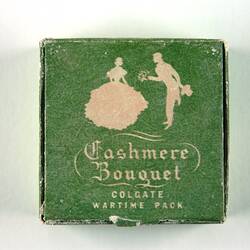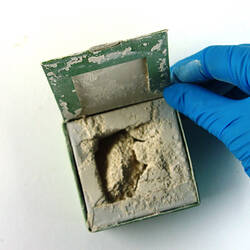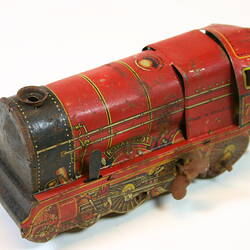Summary
Cashmere Bouquet face powder, Rachel colour, in original 'Wartime Pack', probably made during World War II, 1939-1945.
'Cashmere Bouquet' was registered as a Colgate trademark in 1872 for milled perfumed toilet soap. By the 1940s the Cashmere Bouquet range included face powder, talcum powder, cleansing milk, astringent, cream and powder rouge, foundation and lipstick. The face powder was available in a range of colours: Hawaiian Tan, Sungold, Peche, Rachel and Dark Rachel.
During World War II the Colgate-Palmolive-Peet Company was one of a number of companies that adopted 'wartime packs' or packaging. In this case the powder is loose within the box, with a cut-away under the lid to allow access to the powder. Yardley also introduced 'wartime packs', noting in its advertisements that now consumers 'may have to search a little for them' (Australian Women's Weekly, 7 April 1945, p. 32), implying that the packaging was more plain. This may have been a cost-cutting measure or a mark of austerity appropriate to war-time, although wartime packaging may in some cases have been more symbolic than practical.
Acquired as part of the William Boyd Childhood Collection. The collection includes most of the childhood possessions of William (Bill) Boyd, as well as some general household items. Bill was born in 1947 and raised in the Victorian town of Maryborough. His mother Lillian Boyd preserved the collection for many decades. Upon her death Bill donated it to the Museum of Childhood at Edith Cowan University in Western Australia. When the Museum of Childhood closed the collection was transferred to the Western Australian Museum, but its Victorian provenance saw it later transferred to Museum Victoria.
Physical Description
Cream coloured cardboard box with inscription in green ink. On the back of the box is a silhouette image of a man with top hat and tails handing a lady in a hoop skirt flowers. Hinged lid opens to reveal loose powder, with a narrowed opening to contain the powder.
Significance
Encompassing toys, books, clothing and other items, the William Boyd Childhood Collection is rare in its comprehensivenes: even ephemeral such as the back of a Cornflakes box are included. The Collection demonstrates a range of prominent themes in the lives of postwar Victorian children, such as the ability to 'make do' under austere circumstances; the shift in toy manufacture towards plastic materials and mass production; the continuing cultural influence of Britain; the increasing embrace of American popular culture; the prominence of gender roles; and the popularity of transport and war-themed toys for boys.
More Information
-
Collection Names
-
Collecting Areas
-
Acquisition Information
Donation from Museum of Childhood, Edith Cowan University, Warren Snell - Edith Cowan University, Western Australian Museum (WAM), 13 Feb 2008
-
Date Manufactured
-
Manufacturer
-
Inscriptions
On front: RACHEL / Cashmere / Bouquet / FACE POWDER / SOFT, SMOOTH, CLINGING / DELICATELY / PERFUMED On back: Cashmere / Bouquet / COLGATE / WARTIME PACK
-
Classification
-
Category
-
Discipline
-
Type of item
-
References
Colgate Palmolive web site [Link 1] accessed 27 April 2015 Advertising. (1945, April 7). The Australian Women's Weekly (1933 - 1982), p. 32. Retrieved April 27, 2015, from [Link 2]
-
Keywords



